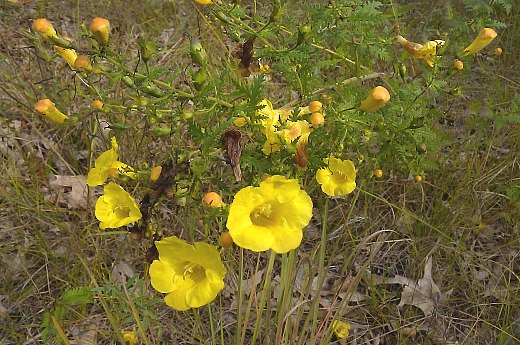Description: This wildflower is an annual or biennial that initially forms a rosette of basal leaves, followed by a much-branched flowering plant that is about 1-4' tall. The basal leaves and opposite leaves of the flowering plant are similar to each other, except that the former are longer in length and less deltoid in outline. The stems are light green to pale purplish green, terete, and moderately to densely covered with spreading glandular hairs. The opposite leaves are up to 3" long and 2" across; they are medium green to purplish green, lanceolate to ovate-deltoid in outline, and bipinnatifid with 3-7 pairs of primary lobes. Usually, the opposite leaves are short-hairy, especially on their lower surfaces. They are mostly sessile, although lower leaves have short petioles. The outer stems terminate in small clusters of 1-3 flowers. Individual flowers are 1¼–1½" long; each flower has a trumpet-shaped yellow corolla, a short green calyx with 5 teeth, 4 stamens, and a single slender style. The calyx is covered with glandular hairs and its teeth are pinnatifid. Along the outer rim of the corolla, there are 5 rounded lobes; they are widely spreading. Within the corolla, there are 1-3 thick lines of reddish brown streaks or dots. The pedicels of the flowers are ½–2" long and glandular hairy. The blooming period occurs from late summer to early fall and lasts about a month. On an individual plant, several flowers can be in bloom at the same time. There is no noticeable floral scent. Each flower is replaced by an ovoid seed capsule about ½" long that has a slender beak at its apex. Each capsule contains many seeds. The root system consists of a taproot and small feeder roots; the latter parasitize the roots of Oak trees for water and nutrients. This wildflower reproduces by reseeding itself.

Cultivation:
The
preference is partial to full sun, mesic to dry conditions, and sandy
soil. It is desirable that a host plant (e.g., an Oak) be present in
the vicinity.
Range & Habitat:
The native Fern-Leaf False Foxglove is occasional in sandy areas of NE
Illinois
and rare to absent elsewhere in the state (see Distribution
Map). Habitats include sandy upland forests, sandy upland
savannas, sandy thickets, and stabilized sand dunes near Lake Michigan.
In all of these habitats, Oak trees are typically present, particularly
Quercus velutina (Black Oak).
Faunal Associations:
The flowers are cross-pollinated primarily by bumblebees, which suck
nectar and collect pollen. Other possible floral visitors include other
long-tongued bees and the Ruby-Throated Hummingbird. The flea beetles Capraita
circumdata and Kuschelina horni feed on Aureolaria
spp. (False Foxgloves). The caterpillars of a Noctuid Moth, Rhodoecia
aurantiago, bores into the seed capsules of these species,
and the aphid Aphis gerardiae has been observed to
suck juices from Fern-Leaf False Foxglove specifically.

Photographic
Location:
A sandy Oak savanna at the Hooper Branch Savanna Nature Preserve in
Iroquois County, Illinois.
Comments:
This wildflower has attractive flowers and ornamental foliage.
Fern-Leaf False Foxglove differs from other Aureolaria spp.
(False Foxgloves) in Illinois by its bipinnatifid leaves, pinnatifid
calyx teeth, and glandular hairs on its stems and pedicels. Other False
Foxgloves in the state have simple or pinnatifid leaves, simple calyx
teeth, and either non-glandular hairs or no hairs on its stems and
pedicels. The flowers of Fern-Leaf False Foxglove are a little shorter
(1½" or less) than the flowers of these other species, and it is
usually more branched and bushy in appearance. Because of these
distinctive characteristics, Fern-Leaf False Foxglove is easy to
identify in the field. Across its range in the eastern United States,
different varieties have been described.